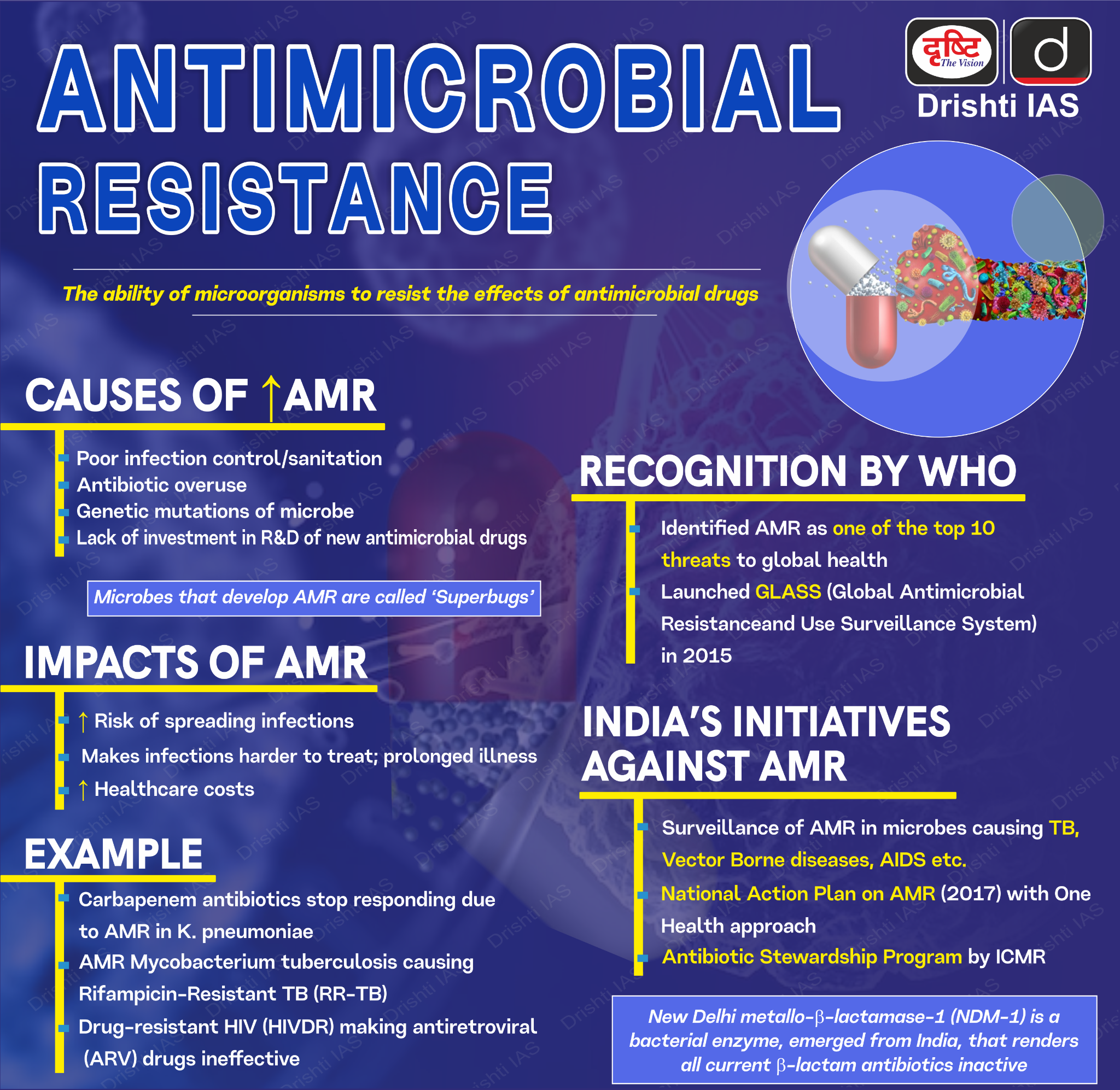Important Facts For Prelims
Lack of Access to Antibiotics Against CRGN
- 02 May 2025
- 5 min read
Why in News?
A study published in The Lancet Infectious Diseases reveals that only 7.8% of patients in India with carbapenem-resistant Gram-negative (CRGN) infections received the appropriate antibiotic treatment, highlighting a severe lack of access to effective treatments for multidrug-resistant infections.
What are the Key Findings of the Study Regarding Antibiotic Access?
- Limited Access to Appropriate Antibiotics: A study of nearly 1.5 million CRGN infection cases across eight low- and middle-income countries (LMICs), including India, reveals that in 2019, out of nearly 10 lakh CRGN infections in India, fewer than 1 lakh patients received appropriate antibiotics.
- Only 7.8% of patients in India received the correct treatment, slightly above the 6.9% average across the eight studied LMICs (Bangladesh, Brazil, Egypt, India, Kenya, Mexico, Pakistan, and South Africa). The lack of proper treatment resulted in an estimated 3.5 lakh deaths.
- Barriers to Effective Treatment: The study identified several barriers, including insufficient diagnostic testing, lack of standardised treatment protocols, and issues with antibiotic supply and affordability.
- Recommendations: The study calls for a two-pronged approach: preserving antibiotics through responsible use and ensuring access for those in need.
- It calls for strengthening antibiotic stewardship programs and regulatory frameworks.
- It advocated for bridging the access gap to ensure that all patients receive the correct treatment.
What is the Carbapenem-Resistant Gram-Negative (CRGN)?
- Definition: CRGN refers to a group of bacteria that are resistant to carbapenem antibiotics, which are typically used as a last line of defense against multi-drug resistant infections.
- These bacteria are classified as Gram-negative, meaning they do not retain the crystal violet dye during the Gram staining procedure, which is used to classify bacteria based on their cell wall structure.
- Examples of CRGN infections include those caused by Escherichia coli, Klebsiella pneumoniae, and Pseudomonas aeruginosa.
- Mechanisms of Resistance: The resistance occurs because these bacteria have developed mechanisms to break down or evade carbapenem antibiotics, often through the production of enzymes called carbapenemases.
- CRGN Infections: CRGN infections can cause serious conditions such as pneumonia, bloodstream infections, and urinary tract infections.
- These infections are challenging to treat due to the resistance to antibiotics.
- Public Health Threat: CRGN infections are difficult to treat and are associated with high morbidity and mortality rates.
- The lack of effective antibiotics to treat these infections can lead to prolonged hospital stays, increased healthcare costs, and higher death rates.
Gram Staining
- Bacteria: These are unicellular microorganisms classified as prokaryotes, lacking a true nucleus. They have a simple structure, including a cell wall, capsule, deoxyribonucleic acid, pili, flagellum, cytoplasm, and ribosomes.
- Bacteria can be classified as gram-positive or gram-negative based on their cell wall composition.
- Gram Staining: The Gram stain procedure distinguishes between Gram positive and Gram negative groups by coloring these cells red or violet.
- Gram-positive bacteria stain violet due to their thick cell wall, which retains the crystal violet stain.
- In contrast, Gram-negative bacteria stain red because their thinner wall allows the crystal violet to wash out during decoloring.
UPSC Civil Services Examination, Previous Year Questions (PYQ)
Prelims
Q. Which of the following are the reasons for the occurrence of multi-drug resistance in microbial pathogens in India? (2019)
- Genetic predisposition of some people
- Taking incorrect doses of antibiotics to cure diseases
- Using antibiotics in livestock farming
- Multiple chronic diseases in some people
Select the correct answer using the code given below.
(a) 1 and 2
(b) 2 and 3 only
(c) 1, 3 and 4
(d) 2, 3 and 4
Ans: (b)
Mains
Q. Can overuse and free availability of antibiotics without Doctor’s prescription, be contributors to the emergence of drug-resistant diseasesin India? What are the available mechanisms for monitoring and control? Critically discuss the various issues involved. (2014)







